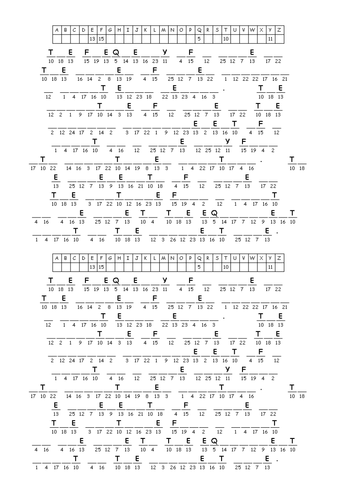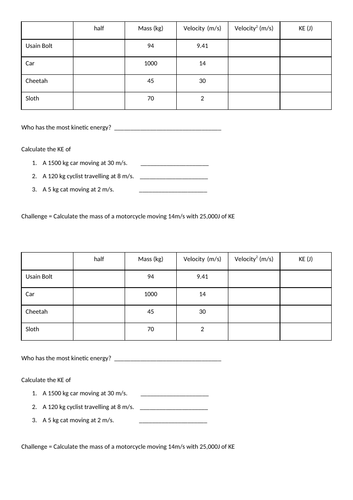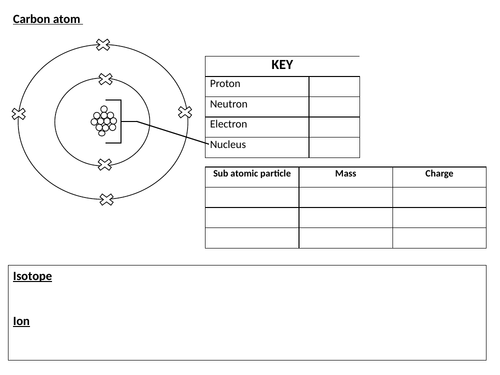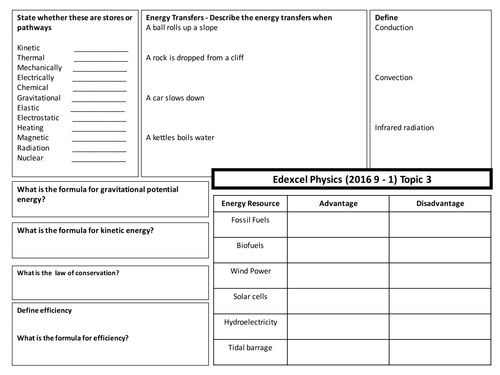
42Uploads
93k+Views
80k+Downloads
Physics

AQA Physics Paper 1 Revision Broadsheet
A broadsheet, or blank knowledge organiser, or place mat
Answers are included
All of paper 1 - Energy, Electricity, Particle Model and Atomic Structure
In PDF and PowerPoint format (which is why it looks like 2 sheets are the same)
For AQA Physics, or AQA Combined Science Physics Paper 1
Each sheet identifies which sections are for triples science and which ones are for combined science
Covers all of AQA Paper 1

Forces Revision broadsheet with QR codes (Foundation)
Forces Revision broadsheet with QR codes, for the foundation tier.
Designed for the AQA combined Science specification, but could be easily adapted for others.
Students should try to complete from memory first, then use the QR codes to revise the sections they can’t answer independently.

Wave Anatomy Cryptogram
Wave Anatomy Cryptogram
Students crack a code to obtain 3 key definitions
**Answer **
The frequency of a wave is the number of waves passing a point each second.
The amplitude of a wave is the maximum displacement of a point on a wave away from its undisturbed position.
The wavelength of a wave is the distance from a point on one wave to the equivalent point on the adjacent wave.

AQA GCSE Combined Science Physics paper 1 feedback
We used the May 2019 AQA paper 1 for the Year 11 mocks.
Rather than going through the markscheme, I have been trying to encourage my students to think about their answers and learn from their mistakes.
I used these sheets as prompts.
In some classes, I printed the slides out and set it as marketplace activity. Others worked through the slides individually on Chromebooks, some did it as group work.
However, the pictures and texts gave students some stepping stones towards the correct answer.

Series and Parallel Circuits - Current and Potential Difference
This activity uses the PhET circuit builder to help illustrate current and potential difference in series and parallel circuits.
It is a basic introduction and does not consider variables such as resistance. However, it is a clear way of demonstrating the rules, if you have unreliable electrical equipment.
http://phet.colorado.edu/sims/html/circuit-construction-kit-dc/latest/circuit-construction-kit-dc_en.html

KS3 Satellites
A KS3 lesson on satellites
Objectives:
Recall ideas about mass, weight and gravity
State what a satellites is
list examples of artificial and natural satellites
Explain the difference polar and geostationary satellites
Literacy starter
Market place activity to find facts about satellites
Kahoot

Uses of Radiation - Research task
A flipped learning/research task for teaching the uses of radiation in medicine and industry. More specifically tailored to GCSE AQA, but could suit other exam boards.
Reccomended pages for pupils who require more structure:
https://www.bbc.com/bitesize/guides/zp4vfcw/revision/1
https://www.bbc.com/bitesize/guides/z2bvdxs/revision/2
https://teachnuclear.ca/all-things-nuclear/radiation/biological-effects-of-radiation/irradiation-vs-contamination/

Atomic Structure and Radioactivity Revision (Lower Ability)
Students watch 3 short videos (links at the end of the document) answering the questions on the first sheet as they watch. Then, they can use their notes and what they have watched to complete the grids on the second sheet.
The word search can be used as a settling starter.
This is aimed at students who struggle with Scientific concepts and lack concentration during revision.

Atomic Structure - Support sheet
A template/writing frame to use for teaching atomic structure, to support students with note taking.

Christmas Science
A selection of Christmas themed Science lessons, including designing and testing hand warmers for Santa and turning pennies into gold.
Most of these resources are my own, some ideas and resources have been borrowed from others. However, I have pooled resources to make a bank of Christmas themed science lessons, so science can be taught right up until the end of term.

Energy Calculations (AQA 9-1 Topic 1)
A worksheet for pupils to practice recalling and using equations. Best used at the end of the topic when all the content has been taught, as all equations from the topic are required.
Starts by recalling units and equations, then asks pupils to apply them to exam style calculation questions. The calculations increase in difficulty down the sheet and are asked at random as they would be in an exam, rather than just repeating one calculation
Answers are provided.

Energy Revision 9-1 - Placemat broadsheet with answers
AQA GCSE Combined Science - Physics Topic 1 Energy 9-1 summer 2018 spec

Planets, Moons and Satellites crossword
For the AQA Space topic, may be useful for other exam boards or curriculums
Planets, Moons and Satellites crossword
Answers included

The link between electricity and magnetism (homework/revision)
Some short answer questions o the link between electricity and magnetism, including a short piece of research on two of the key scientists.

Edexcel (9-1) Topic 6 Radioactivity broadsheet
Radioactivity broadsheet for the Edexcel (9-1) course.
One sheet for both combined and Triple Science students, plus an additional sheet for Triple Science.

Energy Stores and Pathways, Energy resources - Knowledge organiser - Edexcel 9 -1 Physics
Knowledge organiser for Edexcel 9 -1 Physics, Topic 3
Answers provided, both in a format to print or to display

Weight and Mass - Planetary Weight
Useful when teaching the difference between weight and mass. Pupils should illicit the idea that if they were to visit another planet, their mass would stay the same but their weight would change as a result of gravity.
Older or more able groups I ask to research the gravitational field strength. Younger or less able groups I send of a tour of the solar system. Put out the planets and ask them to find the gravity.
Unit for gravity is given as N/kg you may wish to change in to m/s/s depending on group and syllabus.

National Space Centre Mission Booklet
I created a workbook for our Year 7's trip to the National Space Centre in June 2016. As teachers, we found the workbook encouraged pupils to read and absorb the exhibits, rather than just pushing buttons.
I emailed the resource to the NSC, to request their permission to share the resource on TES (as I had added photos of the NSC and a copy of their map). The NSC kindly adapted the booklet to make it look a little more professional and updated questions on exhibits that have changed.
The Space Centre is a fantastic day out, I would thoroughly recommend it. The planetarium is well worth a visit.




















